Home page > President Interview > President Interview (2012 Oct)
President Kisho Inoue Interview
2012 Oct
|
Interview by Mamoru Toyama The chief standing director
-Toyama Thank you very much for taking time in your busy schedule to meet with me, Inoue sensei. First of all, I would like to pay my heartfelt respects and gratitude to the forefathers who accomplished a great feat. They spent much time working for cultural conservation and promotion of the traditional martial arts of Ryukyu (Buki-jutsu, Toshu-jutsu). I am also grateful to members of the Society for their endeavor for the arts under the mentorship of the grand master Gansho (Motokatsu) Inoue in this rapidly changing century. Now, it has been more than 20 years since you succeeded to the presidency of the Society in 1993. On this occasion, I would like to ask you about the history of the Society and deliver it to the next generation. -Inoue I would like to express my gratitude to you, Mr. Toyama for holding such opportunity. I hope that my story will serve as a useful reference including the previous president and the supreme adviser. I was 38 years old when I assumed the position of President. At that time, we were developing our activities for growth in Japan and overseas. When I look back at that time, I made up my mind to take over the mission of the grand master when he was in hospital. Since his passing away, the Society owes generously to the co-operation and support by the chief director, directors, secretariats, shihans (masters), branch chiefs, and all members of the society. They have supported me for 20 years. Especially, I wish to express my sincere thanks to the shihans who were the direct apprentices of the late master and are now around 70 years old. They became the disciples of the late master from high school age and had learned a lot from him. I know they have great gratitude to him, from the bottom of my heart. I really appreciate their efforts and believe their sincere attitude is to repay the great gratitude. -Toyama What was the inspiration for the late grand master Gansho Inoue to start martial arts? -Inoue At first, he received guidance from his father Saburo, who is my grandfather. He was a military man and a member of the House of Lords prior to the Second World War. He and his wife, Chiyoko, had four children and the late grand master was the second elder brother. The eldest brother, my uncle, was a professor emeritus at the University of Tokyo. He was famous for his knowledge of ancient Japanese history. He was on the staff of Harvard University for one year from August 1961. In his later years, he was committed to the establishment of National Museum of Japanese History in Sakura city, Chiba Prefecture, and became its first curator. Just before the museum opened, he passed away at the age of 65 on February 27, 1983. His parents Saburo and Chiyoko gave their children a lot of opportunity to learn sports and martial arts in their childhood. During the late grand master's childhood, he was a physically weak child. However, he had never-give-up attitude and trained himself to become physically strong when he was at school. He took part in many competitions of such sports as sumo, ski and wrestling with good results. There is no doubt that he had an athletic interest. In 1935, he became acquainted with a master Fujita Seiko sensei through Saburo. He met Fujita sensei in connection with military. Fujita sensei had a friendly relationship with the Inoue family and relatives. He was not a security guard as some people erroneously believed. When the late grand master was a university student, the Second World War broke out. His grade was moved forward and he graduated from the university early because of student mobilization. He went into military service and belonged to the unit of the foot guard and entered Army Reserve Academy in Sendai. After that, he went abroad to the battlefield in Burma, and participated in the Battle of Imphal. During the rainy season in Burma, he and his unit suffered severe physical conditions that included being submerged up to their waists in muddy water from heavy rain. They also suffered extreme exhaustion, as a result of severe food shortages as supply lines were severed, as well as the spread of infectious diseases, such as malaria, and ongoing intense gun battles. They were so overburdened that they could feel the extra weight of even three grains of rice. Such harsh conditions caused many deaths, and the Battle of Imphal is regarded as one of most disastrous battlefields, and became known as "the skeletal road". He was captured and held as a prisoner of war by the British Armed Forces of the Crown, and eventually released and allowed to return home to Tokyo, where he found that his family's house had been destroyed in an air raid. He kept the misery of the war in his mind, and thanked God for the fact that he could survive. At the same time he wondered how to live the rest of life. The foreign corporation that he was supposed to work for, had already left Japan. Finally, he made up his mind to focus on the youth, and help them to grow up responsibly for the future of Japan through martial arts. He built a "dojo" and started to train himself again. The dojo was built as a part of his new house in Shimizu that was built in the empty ground of the second house that was burned down during the war. He re-started training under the guidance of Master Seiko Fujita. On his orders, he studied "karate" under Master Yasuhiro Konishi and the ancient weapons martial art of Ryukyu under Master Shinken Taira whom he met before the war. From then on, he devoted his life to his own ascetic training, to help the youth, and to preserve and promote the arts. -Toyama The master Gansho Inoue sensei applied a word "Yuishin". Why did he start to use this word? -Inoue He asked his teacher Master Seiko Fujita, the 14th master of Koga Ryu Ninjutsu, for advice on the name of the dojo he had built in Shimizu. Together with Master Hosaku Sodeyama sensei, who was a visiting master of Mr. Konishi, he named the "dojo" as "Yuishin". "Yuishin" is a word in Buddhist scriptures that means the heart (or "kokoro") is the only and most essential entity. Why did he choose this word? It was because he thought it crucial to emphasize the way of the heart for peace and restoration of new Japan. He told me that he chose "Yuishin" because this word was most appropriate to express his strong desire and deep thought for that. In the early stages it was for the sake of Japanese children who were to build future of Japan. As it spread all over the world, his message became one for children worldwide. In the meanwhile, in the dojo before training, children used to chant together in loud voice the following 5 slogans: 1. Be polite and show good manners 2. Clean the mind and body, and be tidy 3. Listen to the others without prejudice, and make best efforts 4. Be friendly with dojo members and help each other 5. Be a better child through the practice of karate The messages the master delivered through the above slogans are: (1) that "kokoro" or mind is the most important element of the technique and (2) to utilize what you have learnt in daily life and endeavour to create a peaceful society. Our everyday training and activities are for that purpose. | |
|
-Toyama I would like to ask you about a genealogy of "Ryukyu Kobujutsu Hozon Shinko Kai" [the Society for the Preservation and Promotion of Ryukyu classical martial arts]? -Inoue This is an autographed genealogy written by Master Shinken Taira given to the master Gansho Inoue showing following line: Master Aburaya Yamashiro - Master Yamani no Chinen - Master Moden Yabiku - Master Shinken Taira- the Master Gansho Inoue Before the above genealogy, there were several famous masters such as Master Sakugawa, Master Soeishi, and Master Chinen Shichanaka. Master Shinken Taira had his disciples in both Okinawa and the mainland across Japan. Among them, Master Shinken Taira conferred a full mastership only on Gansho Inoue as the first "Menkyo Kaiden Hanshi" master. In the full mastership, all "kata" - over 40 and consisting of 8 kinds of weapon - were handed down to the master Gansho Inoue. Master Shinken Taira had a dream that one day he would be able to spread the Ryukyu classical martial arts not only in Okinawa and the mainland but also around the world. He sincerely entrusted its realization to the master Gansho Inoue. He sent letters expressing such strong wishes to the Grand Master. One letter included the autographed line of genealogy. I think that it will be natural to hand down traditional arts to local people. However, Master Shinken Taira observed from a broader perspective , from spending time in both Okinawa and the mainland, that there was also value in selecting a successor beyond the local people, and judging them by their character and other personal qualities. |

|
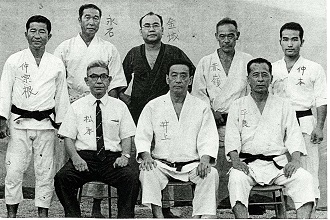 First line from left M/S Matsumoto, Inoue and Taira (another Taira) Second line from left M/S Nakasone, Nagaishi, Kinjo, Akamine and Nakamoto | |
|
After master Shinken Taira passed away on September 3rd 1970, we performed together at the Memorial Demonstration of Ryukyu Kobudo for Okinawa reversion to Japanese sovereignty held in Shimizu citizen hall. However later day,as a result, at a meeting attended by master Yuchoku Higa, master Eisuke Akamine and master Gansho Inoue, it was decided that each would go his own, separate way. Just after that, master Higa and master Matsumoto came to master Gansho Inoue in Shimizu to confirm the separation. -Toyama Please explain the reason for changes of the name of the Society. -Inoue Both Okinawa and the mainland Japan had used the same name of "Ryukyu Kobudo Hozon Shinko Kai = The Society for the Promotion and Preservation of Ryukyu Kobudo". From 1970's, members from abroad increased and to avoid confusion, we changed the name of society to " Ryukyu Kobujutsu Hozon Shinko Kai = The Society for the Promotion and Preservation of Ryukyu Kobujutsu". We changed "Do" to "Jutsu". It was because master Shinken Taira had an idea of changes of the name along with the original name of "Ryukyu Kobujutsu Kenkyu Kai = The research association of Ryukyu Kobujutsu" founded by his teacher Moden Yabiku. -Toyama Please explain about the accomplishment of master Shinken Taira and the master Gansho Inoue. -Inoue The achievement of master Shinken Taira is a compilation of 42 weapons kata using 8 different kinds of weapons. He spent years pursuing the arts under master Yabiku. He learned kata and explored techniques of Ryukyu ancient martial arts that had survived or been buried in various regions of Okinawa. (There are some other archived kata unreleased to public.) In the 42 kata, there is The "Ji" in Jigen means affectionate love and "Gen" in Jigen means "Moto" (this is the Chinese reading of "Gen") of Motokatsu Inoue One of accomplishments the master Gansho Inoue achieved over a long period is the establishment of practice system. This system is composed of a series of techniques consisting of methods for use of 8 kinds of weapons, basic Kumite and breakdown Kumite. He accomplished this great achievement by order of his teacher master Shinken Taira "to establish a set of arts by which students can understand and relate to the meaning of each kata during course of practice". Furthermore, he published books of three volumes of "Ryukyu Kobujutsu". He authored these works for preservation of around 40 kinds of kata that were handed down when full mastership of "Menkyokaiden" was conferred on him. He also published another two books: "Ten no maki: the volume of the heaven" and "Chi no maki: the volume of the earth". In these two works, he systematized 8 kinds of elementary techniques. In "The volume of heaven", he wrote about "Bo-jutsu", "Sai-jutsu", "Tonfa-jutsu" and "Nunchaku-jutsu". In "The volume of the earth", he wrote about "Kama-jutsu", "Tekko-jutsu", "Tinbe-jutsu", and "Surujin-jutsu". He published these works at his own very considerable expense because he believed strongly that "We must preserve these kata forms forever in writing. We shall not make it someone's personal belongings because these are important cultural heritages in Okinawa." -Toyama Next, I would like to ask you a genealogy of Yuishinkai Karate? -Inoue Here is the genealogy of Yuishinkai Karate. Sokon Matsumura - Yasutsune Itosu - Gichin Funakoshi - Yasuhiro Konishi (and a guest master Hosaku Sodeyama) - Gansho Inoue | |

| |
|
-Inoue The above-mentioned genealogy is a line of teachers he studied under. At present time, Konishi sensei's son, master Tatehiro Konishi inherited Ryobu-kai from Yasuhiro Konishi sensei. Inoue sensei was certified with the rank of 8th dan by master Yasuhiro Konishi and appointed as the head of Tokai district of Ryobu-kai. His dojo "Yuishin-kai" became the place to study the teachings of master Seiko Fujita, master Yasuhiro Konishi and master Shinken Taira. Fujita sensei appointed him the branch head of Tokai district of "Japan martial arts research institute". However, as the numbers of students of Ryukyu martial arts progressively increased in the 1970's, master Gansho Inoue felt it would be better to separate Ryukyu Kobujutsu from Yuishin-kai for promotion, and made "The Society for the Promotion and Preservation of Ryukyu Classical Martial Arts" an independent organization. This enabled students who practice other styles of Karate to practice Ryukyu Kobujutsu. -Toyama Would you please tell me a memory of the master Gansho (Motokatsu) Inoue? -Inoue Well, he was courteous and strict. Firstly, he was strict with himself. I will never forget that he practiced so hard at keeping silent. In the later years, he always said that "though we can use video in these days, the most important thing is to learn by your own body and continue the practice every day". In daily life, he was pleasant and a silent person. He enjoyed taking his pupils out for a drink in kimono after practice. He had close relationships with his brothers. His nephews and nieces adored him, calling him "Uncle Moto! Uncle Moto! During his college days, he seemed to have a joyful character. After he returned from the war his friends around him nicknamed him "dream king". He was also a very organized person. His daily life was filled with Zan-shin (a posture and attitude of focused awareness). He was very good with his hands. He made a guitar using old used wire from the English army. He made these articles during physical labour under the order of Lord Mountbatten after Japan was defeated in Burma. In the internment camp, he also organized a musical party and had musical performances in a bazaar and at a reception, to which he and his party were invited by the English army. I keep the guitar my father made close to me. He made weapons with same cleverness of hand. He was also good at painting and tried to see beauty in all thengs. He was a man of patience. He had a great inner strength and intellect that helped him to survive during the war. After the WWII, he regarded the time left alive as borrowed time. He was an attractive charismatic person and many people naturally gathered around him. Subordinates adored him both during and after the war. -Toyama Please tell me more of your memories of Master Seiko Fujita sensei. -Inoue Fujita sensei was a strict but warm character. He treated my father and mother as his own children, and was always very affectionate to me. He was a visionary person and had mysterious, magical abilities such as telegnosis, interpretation and healing . To round off Inoue sensei's knowledge of the martial arts, Fujita sensei introduced master Shinken Taira of Ryukyu Kobujutsu to Inoue sensei. At the time only few people learned Ryukyu Kobujutsu. However, he felt it would flourish in the future. He knew about the world of martial arts. He was a good advisor for us with far-sighted view. One example of his telegnosis: He said to my mother: "You are pregnant. It's a boy", before she even knew she was pregnant. When I was born, master Seiko Fujita gave me my first name. For information, Kisho is my budo name. "Kisho" of Kisho Inoue is a name in martial arts. The following picture is of me, taken with master Fujita when he came to our house in Shimizu. He loved me as if I were his real grandson. | |
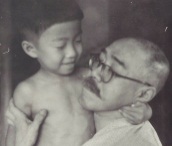 With Fujita sensei (1950s) | |
|
Fujita sensei passed away in 1965 when I was 11. We, Inoue family and relatives had close interchanges with him, received his guidance and warm consideration for long time since the pre-war age. I am very proud of such close relationships with Mrs. Fujita, their daughter and son. -Toyama What did the previous president Gansho Inoue learn from Fujita sensei? -Inoue Gansho sensei learned from him the comprehensive martial arts such as Shuriken-jutsu, the art of throwing knife as Shingetsu-ryu, Nanban-satto-ryu Kenpo, Hojo-jutsu, the art of rope capture, and Jo-jutsu of stick and so on. Gansho Inoue sensei learnt and preserved the techniques of Nanban-Satto-Ryu and incorporated it as one of the basis of Taijutsu of Yuishin-Kai. Manzo Iwata sensei became the successor of the tradition of Nanban Satto Ryu He had achieved the degree of Shihan (master) of Shingetsu-ryu Shuriken-jutsu. -Toyama What is important point for Shuriken-jutsu? -Inoue Gansho sensei said " Don't be tense, use relaxed power. -Toyama Did you also train that? -Inoue Yes, I learned it from Gansho sensei. -Toyama A lot of masters visited the house in Shimizu, I guess. -Inoue Many masters came to our house in Shimizu , such as Seiko Fujita sensei, Shinken Taira sensei, Yasuhiro Konishi sensei, Yuchoku Higa sensei,Kiyonobu Ogasawara sensei, Kisshomaru Ueshiba sensei, Gozo Shioda sensei, Ichitaro Kuroda sensei, etc. Such great masters in the worlds of ancient martial arts and Karate visited the house in Shimizu. I am grateful for such lucky circumstances. Gansho sensei had also met with Choki Motobu sensei and Kenwa Mabuni sensei. He met Gichin Funakoshi sensei at Keio University. | |
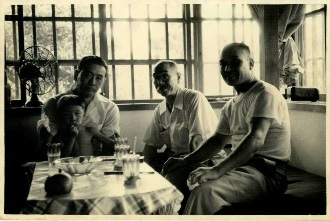 From left: Kisho Inoue, Gansho Inoue sensei, Seiko Fujita sensei, Ichitaro Kuroda sensei at old home in Shimizu 1959 (Kisho Inoue 4 years old) | |
|
-Toyama I would like to ask you about master Shinken Taira. -Inoue He was born in Kumejima of Okinawa (1897-1970). He had named himself as Taira or Maezato (his mother's registered family name) as his family name. When he was young, he suffered a broken leg at work and had some difficulty in walking as the after-effect. From his photograph in youth, he seemed to be a muscular man. | |
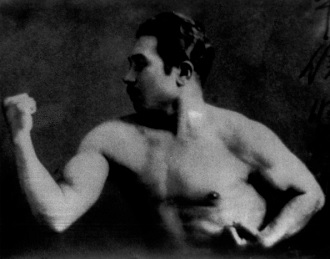
| |
|
Before the war, he had many opportunities to meet and interact with great masters Moden Yabiku, Gichin Funakoshi, Kenwa Mabuni and Seiko Fujita during his stay in the main land for work. He had tried to spread Karate under Gichin Funakoshi sensei. Once, he lived in Ikaho in Gunma prefecture. When he was there, he worked for a related corporation of Nissan Motor Company. He had a high skill in driving a large car, disassembling and reassembling "the Ford model T".
He wrote a lot of letters. He sent letters to Gansho sensei too, which I have and keep. He was good at music and dance. In 1940, he received an advice from master Funakoshi and returned to Okinawa to devote the rest of his life in Okinawa for the preservation of Ryukyu ancient martial arts. When he visited the house in Shimizu, he stayed at either an annex of our house named "Keikou-an" or in our home. When he stayed, he often played around with me. There used to be a street car in Shimizu. I remember that I and master Taira together got on a train and went to the street of "Shimizu Ekimae-dori". The longest stay at Shimizu was for around 2 months. He taught me face to face during such long stays. | |
 Extract from commemorative photo album made by Shinken Taira sensei (Kumite right: Kisho Inoue's younger sister.) | |
|
In 1970, he passed away. Gansho sensei had nursed him for a month from August. He stayed in Okinawa taking care of him day and night. Taira sensei's students often visited him during that period. He made his best efforts to raise funds for master Taira in building a dojo and publication of the works. The relationship between master Shinken Taira and Gansho Inoue sensei was very close. I take heart from the fact that their accomplishments formed the basis of the present foundation of Ryukyu ancient martial arts. Master Taira said "the relationship between master and disciple lasts for 3 generations, although it is said that the relationship between parent and child lasts for one generation and relation between husband and wife lasts for 2 generations" Master Taira composed a poem for the dojo "Yuishin-kan". | |
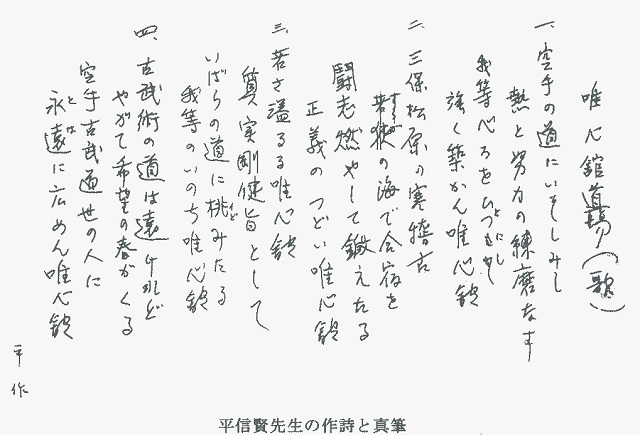 Poem composed by Shinken Taira sensei
Poem composed by Shinken Taira sensei
| |
|
Poem of Yuishinkan Dojo Shinken Taira 1. Training in the way of Karate, We practice with energy and spirit, With a single mind, we strive, To make Yuishinkan strong 2. Midwinter training at Miho beach, Training camp in the Suruga Bay, With fighting spirit we gather, Defending justice at Yuishinkan 3. Yuishinkan, filled with young power, With sturdy bodies and iron wills We challenge the thorny path. Our life is in Yuishinkan 4. Martial arts ,a life-long challenge, but Spring, filled with hope, will soon arrive. Karate, Kobudo for the people we train Enduring mission of our Yuishinkan. (Translated by Nobuo Tokumatsu) | |
|
-Toyama Please tell me about your memories of Yasuhiro Konishi sensei. -Inoue I had fewer opportunities to meet Yasuhiro Konishi sensei than masters Fujita sensei and Taira sensei. I met him in 1960's when he visited the United States of America, in 1970's when his second dojo was established, and in 1981, that is my most impressionable memory, when he proposed a toast at my wedding ceremony. It is my great pleasure to maintain such long and good relationships with his son, Tatehiro Konishi sensei and his wife. He has been giving us precious advice as an advisor to the board of the Society. -Toyama From when did you enter the world of martial arts? -Inoue My father, Gansho Inoue, was a professor of martial arts. So since I was born, I grew up in the environments of martial arts. My father always kept in training. A private dojo for him was built in the house. | |
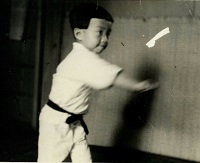 Shuriken throwing at Gansho Inoue's private dojo 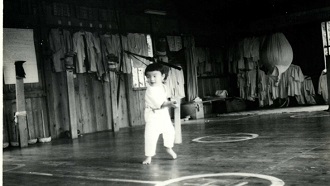 My younger sister at the first dojo in Shimizu | |
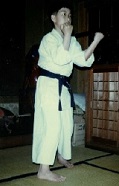 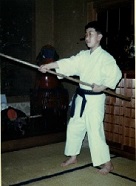 Kisho Inoue in 1967 | |
|
I feel extremely fortunate that from the beginning of my practice I had been taught one on one by my father. At the time of junior high school, I used an honorific title when addressing my father. I think that from a very young age, I already had an awareness to regard him as a teacher. -Toyama What was the exam for grading by the previous master? -Inoue He directed me in the same way as his master directed him. Randomly, he demanded that I demonstrate this Kumite and that Kata. In order to make it possible, I had to practice and review Kata and Kumite again and again. I think that his aim for the exam was to teach importance of repetition in practice. -Toyama Why did you choose to practice Kendo during your school life? Is there any common point between Kendo and ancient martial arts? -Inoue As you know, in Japan, students enter club activities during school life. When I entered junior high school, there were three clubs such as Judo, soccer and Kendo. According to my father's advice, I chose a kendo club. I kept practicing Kendo when I was in junior high school, high school and university, and even when I was a working member of society. It is certain that from the Kendo practice, I was better able to make the use of body movements, Maai (to take a suitable distance), and Taisabaki (to manage foot and body). -Toyama Have you ever had some opportunities to study martial arts other than Ryukyu Kobujutsu, Karate-jutsu, Kendo ? -Inoue I learned Shuriken-jutsu (the art of throwing knife), Hojo-jutsu or Nawa-jutsu (the art of restraint using rope) I understand that the variety and depth of the coverage in Yuishin-kai and Ryukyu Kobujutsu are rich and profound. So grasping their essence is a life-time training and practice. -Toyama Please tell me your memories of the Dojo. -Inoue At the beginning, Inoue sensei used a room with a wooden floor for training. Then, the first large Dojo, that is most memorable one to me, was set on the second floor of a warehouse next to our premises. In 1958, when I was 4 years old, my father started to accept disciples formally. Since then, this Dojo was there until I entered university. The Dojo was surrounded by full, rich nature such as mountains, rivers, the sea, tea plantation, orange garden, trees of apples and marshy places, though there is nothing left now. The original houses on the land were burned down during the Second World War. | |
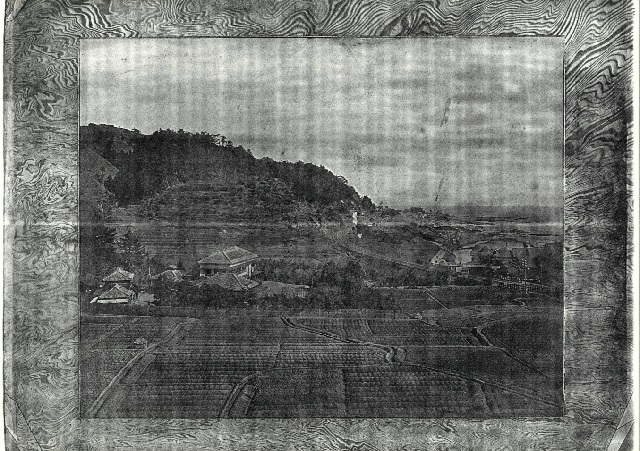 a stretch of the premise over 100 years ago. Suruga Bay is seen on the right | |
| The second Dojo of general HQ was built on the land next to the mountain Choja-yama in 1973. | |
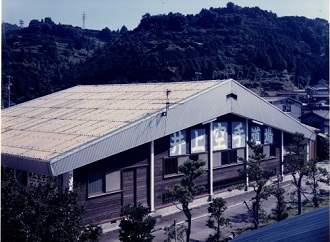
| |
|
During the1970's the disciples from various foreign countries came to Japan. They were Robert Zwartjes from Netherlands, Jee Tee Meng from Malaysia, Paul Starling from Australia, John Sullivan from United Kingdom, Shane Higashi from Canada, Edward Jardine from South Africa and Ilpo Jalamo from Finland, and followed by Julian Mead from UK. In 1990 when Inoue sensei and Mrs. Inoue moved to Tokyo, we had transferred the land in Shimizu to Shizuoka City. At the site, the Shizuoka City Buried Cultural Properties Center was built where we can see, experience and learn about the buried cultural assets of Shizuoka City. The third Dojo of general HQ is set at "Zoshukan" in Shibuya-ku, Tokyo. This is the Dojo built at the premises of Toyosaka Inari shrine by chief priest Hiruma Guji in 1975. From the beginning of its opening, we have been using it for the practice of Ryukyu Kobujutsu. This Dojo was positioned as a new base and venue for the accelerated spread of Ryukyu Kobujutsu. I remember that many overseas disciples of our global family visited Shibuya and Shimizu and practiced together with us. After the international seminar 2010, around 100 overseas members who could extend their stay visited the Dojo in Shibuya. It was a precious time for them because they could listen to the address by Keiko Akutsu sensei, the second director of Zoshukan, and Yasuyo Inoue sensei the supreme adviser of the Society. -Toyama Please tell me key points on how to learn Kata forms. -Inoue The previous master put up a frame of "Itosu no Jukkun" (or ten directive teachings of Itosu) written by master Yasutsune Itosu in the main wall of the Dojo. He treasured it as an important one. Needless to say, the mental and technical preparations as shown in the ten directive teachings of Itosu are to apply as well to the traditions and to the martial arts. Certainly, the handed down kata and weapons must remain intact. Besides, we must be careful about the creation of new weapons and new Kata befitting to the tendency of the time. It is our responsibility to protect the integrity of kata and the Kumitejutsu handed down from the master Inoue. There is strictness of the preservation promotion. People must not be allowed to create new kata on a whim. -Toyama For preservation, all Kata of Yuishin-kai karate were documented in 1996. -Inoue Forty one kinds of Karate kata, from the lines of Shuri, Tomari, Naha, and Aragaki, are published in the book. It is mandatory for pupils who study Karate technically to learn these 41 kata. By order of the late master, the major shihan gathered at the Dojo in Shimizu and recorded these kata before his passing away. After he passed away, I edited and compiled the detail of the kata for publication, and distributed the books to the branch chiefs of Yuishinkai. -Toyama At present, the supreme adviser Yasuyo Inoue is 88 years old and healthy. Would you please talk about her? -Inoue She is mother of the global family, and continues to devote her life to the family, to Yuishinkai, to "the Society", to the previous master, who had presented her with a special letter of appreciation, and for the members. On the other hand, she has continued researching Japanese history as her life work for 80 years since school. Her special areas of study have been each stream of the Japanese history for 2010 years of the Christian era and for about 2700 years of the Jimmu era. She has published some of her research. During her school years, martial arts were one of the required subjects, taught by noted teachers. She learned archery, Naginata (Japanese halbert), Bo-jutsu (Jo-jutsu) and so on, and still remembers the names of her distinguished teachers. Due to her age and after major surgery, her vision has declined, and she is physically impaired. We should follow her example and attitude of "study for lifetime and learn forever". My mother often says:"The changing of shapes of places of historical interest reflects the changing of the times. Such place of historical site changes. But, the footmark that you stepped on in the site reflects all the times". She also says: "It is very important for us to look for and clarify the problem and after that you can keep pursuing the problem. " I think that her belief is spread and carried out in various kinds of fields in life. -Toyama What does the Disciple learn from Martial Arts? -Inoue It is from constant practice and repetition that we can learn the wisdom in the techniques passed down from Old Masters. As we sincerely study we continue to appreciate the depth of the martial arts and the great achievements of Old Masters. This makes me feel a deep sense of humility. -Toyama Why is this so? -Inoue It is because there are beliefs we have that are growing and developing. These are according to the word of the previous master: "Always have an ambitious and a modest state of mind." All we have to do is humbly to repeat practices. It is necessary for us to make constant efforts in order to demonstrate our vast ability on any given occasion. Even without weapons, it is possible for us to learn weapon martial arts. It is whether we keep steady attitudes or not. It must be hard. However, in the repetition we come to question. We get to comprehend it. And we master it. We repeat this cycle. This way lasts forever. This is the essence of the way in every aspects of our endeavors in life. -Toyama Thank you very much, Inoue sensei. Today I could listen to your valuable story. I would like to have another opportunity to listen about more topics, hopefully in near future. -Inoue I also thank you, Mr. Toyama, for this opportunity to talk about Ryukyu Kobujutsu and Inoue family. | |
Over by Kisho Inoue
Translated by Mr.Yoshitaka Nomura

